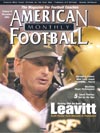AMERICAN FOOTBALL MONTHLY THE #1 RESOURCE FOR FOOTBALL COACHES
Article CategoriesAFM Magazine
|
Disciplined DestructionAnalyzing Furman\'s 4-3 Defenseby: Steve Wilson Defensive Coordinator, Furman University © More from this issue We have been fortunate to have many really good defenses at Furman over the past 20 years and that system has evolved from what use to be the 50 Defense to what we now call our Stack Defense. This is not the only defense that we run but it is our primary system and what we start teaching with. Like most schools it is our primary objective to stop the run first and then the pass. We do have some consistent goals that we would like to accomplish every week and then some we try to establish from week to week depending on what type of team that we play. Our constant goals are these: • Beat opponent • Allow less than 13 points • No me....The full article can only be seen by subscribers. Subscribe today!
|
|
|||||||
| HOME |
MAGAZINE |
SUBSCRIBE | ONLINE COLUMNISTS | COACHING VIDEOS |
Copyright 2025, AmericanFootballMonthly.com
All Rights Reserved





